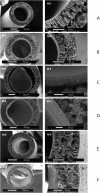New low-flux mixed matrix membranes that offer superior removal of protein-bound toxins from human plasma
- PMID: 27703258
- PMCID: PMC5050520
- DOI: 10.1038/srep34429
New low-flux mixed matrix membranes that offer superior removal of protein-bound toxins from human plasma
Abstract
Hemodialysis is a widely available and well-established treatment for patients with End Stage Renal Disease (ESRD). However, although life-sustaining, patient mortality rates are very high. Several recent studies corroborated the link between dialysis patients' outcomes and elevated levels of protein-bound uremic toxins (PBUT) that are poorly removed by conventional hemodialysis. Therefore, new treatments are needed to improve their removal. Recently, our group showed that the combination of dialysis and adsorption on one membrane, the mixed matrix membrane (MMM), can effectively remove those toxins from human plasma. However, these first MMMs were rather large in diameter and their mass transport characteristics needed improvement before application in the clinical setting. Therefore, in this study we developed a new generation of MMMs that have a smaller diameter and optimized characteristics offering superior ability in removing the PBUT indoxyl sulfate (IS) and p-cresyl sulfate (pCS) in comparison to first generation MMMs (30 and 125% respectively), as well as, a commercial dialysis membrane (more than 100% better removal).
Figures






References
-
- Eloot S., Van Biesen W. & Vanholder R. A sad but forgotten truth: The story of slow-moving solutes in fast hemodialysis. Semin. Dial. 25, 505–509 (2012). - PubMed
-
- Dou L. et al.. The uremic solutes p-cresol and indoxyl sulfate inhibit endothelial proliferation and wound repair. Kidney Int. 65, 442–451 (2004). - PubMed
Publication types
MeSH terms
Substances
LinkOut - more resources
Full Text Sources
Other Literature Sources

